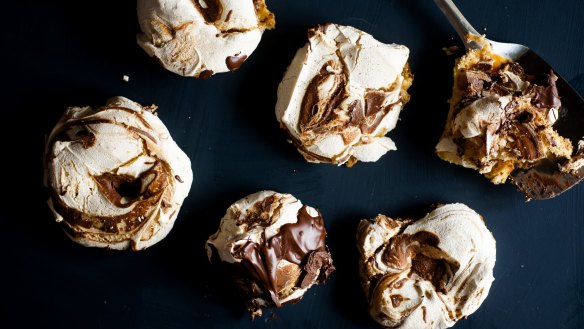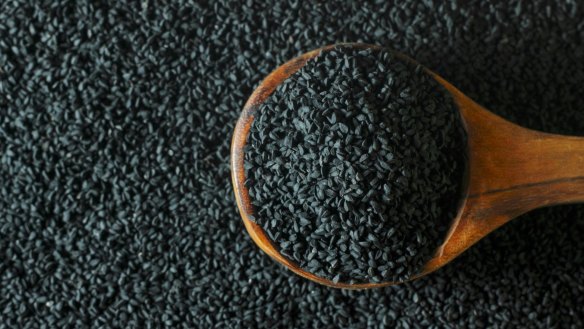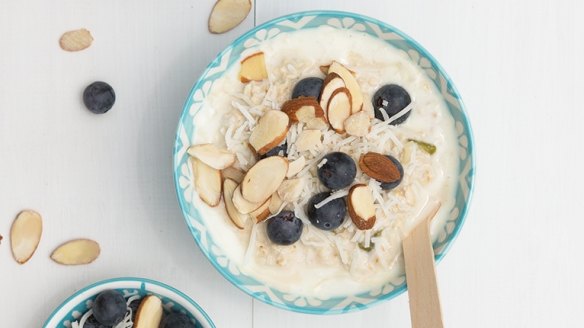Aquafaba to zig zag vine: Test your kitchen knowledge with the A to Z of kitchen trivia

- Best of Brain Food: Everything you need to know about ...
- What is aquafaba (and four ways to use it, including how to make chocolate ripple meringues)
Growing up in regional Victoria, Anthony Telford learned everything he could about growing and cooking food.
But even years later, having worked in kitchens across the country since the age of 15, the now Sydney-based chef found himself frustrated at trying to find quick answers to common kitchen questions.

His new book, The Kitchen Think, aims to remedy that, with more than 600 tips, tricks, hacks and explanations for anyone who loves cooking.
Put your kitchen knowledge to the test with this A to Z glossary of less common food terms.
Aquafaba
The liquid drained from canned chickpeas is known as aquafaba, and is a very useful alternative for vegan cooks. Aquafaba mimics the functioning properties of egg whites, making its use in meringue-style desserts a blessing for vegans and for those with egg allergies.
Broccoflower
Broccoflower is a relatively new vegetable, no doubt developed by bored agricultural scientists. A cross between broccoli and cauliflower, it has a bright, light-green colour and a milder flavour than either of its parents.
Clabber
Clabber is a curdled or soured milk (the name derives from the word's use as an archaic word for pantry). Unpasteurised milk is left to sit for two or three days until it curdles. The cream is removed to produce clabber cream or creme fraiche. Clabber is eaten as is or with a little black pepper or nutmeg, cinnamon and brown sugar and a splash of fresh cream. It can also be strained overnight in cheesecloth to produce a kind of cottage cheese.

Duff
Not the beer favoured by Homer Simpson, but the name of an English pudding: plum duff is a type of steamed pudding with dried fruits – really another name for plum pudding or Christmas pudding.
Epazote
Epazote is a pungent herb used especially in bean dishes in Central American countries, Mexico and New Mexico. It is said to make the beans more digestible. Also available as a powder.
Fool
Fool is a simple dessert of crushed or mashed fruit mixed with cream (usually whipped cream). The name is said to derive from "fouler", the French word to mash. The fruit can be fresh, poached or stewed. Fruits rich in acid, such as raspberry, rhubarb and passionfruit, are commonly associated with fool, but mango, apricot and papaya also work.
Garum
From the ancient Romans comes this fermented fish sauce. An excellent condiment, full of rich umami flavours. Good chefs will waste no part of the fish to make their own garum.
Horchata
Horchata is a milk substitute made from chufa (tiger) nuts, the tiny tuberous roots of a Middle Eastern plant or almonds. Mexican horchata, also a dairy substitute, is made from rice and tastes completely different.
Isinglass
Isinglass is a gelatine-like thickener obtained from cleaning and drying the inner lining of the air or swim bladders of a number of fish species, in particular sturgeon and cod. It is used to thicken or clarify especially in the wine industry where it is used as a "finer".
Jujube
Jujube a small fruit also known as the Chinese date. The skin turns from a yellowish-green to red when ripe (although it can be eaten before it is fully ripe). Both the skin and flesh are crisp and sweet, and it can be stewed, candied, dried or simply eaten fresh.
Kombu
Kombu is a primary ingredient in dashi. This seaweed enhances the taste of many dishes as it is an outstanding source of monosodium glutamic acid, the natural version of the chemical flavour-enhancer monosodium glutamate. Look for very dark, almost black examples of this dried seaweed, remembering not to wipe off the white residue on the surface, which contains much flavour.
Luffa
Luffa is picked, sold and used when unripe. (The overly mature fruit forms sponge-like fibres which, when dried, are made into those scratchy bath sponges women love and men just don't get.) The many varieties available are found in Asian grocers, some resembling large okra, named angled luffa or Chinese okra, others called dishcloth luffa or sponge gourd. In most cases, treat luffa as you would zucchini.
Mole sauce
Mole sauce, a Mexican sauce to accompany meat, was invented by a nun, based on an ancient festival dish eaten by the Aztecs. It is made with Mexican chocolate (not the same as chocolate used to make sweets and desserts), often as little as 30 grams for a recipe to serve with a whole chicken. Other ingredients in this thick sauce include plenty of red chilli, onion, garlic, herbs (oregano, thyme, parsley), tomatoes, sesame seeds, allspice, cloves and cinnamon. Mole served with chicken and turkey tastes better than it sounds.

Nigella
Nigella, also known as kalonji or charnushka in the US, are the teardrop-shaped, black and pungent seeds from a bush found throughout India. This aromatic, slightly bitter spice is used to give a nutty edge to curries and breads, and in Middle Eastern and Turkish cuisine. Kalonji should not be confused with black sesame seeds (kalonji have a more angular shape to the seeds), black onion seeds or black cumin.
Okra
Okra, also known in many English speaking countries as ladies' fingers or ochro. A member of the mallow family of plants, which include durian, cocao and cotton. Okra is prized for its edible green seed pods and favoured in the southern US, West Africa, India and southern Asia. When cooked, the characteristic slime or gooey texture is valued for its ability to assist in thickening wet dishes such as sauces, soup (gumbo) and stews. Dried okra can also thicken sauces. The viscous mucilage can be reduced by adding acidic foods such as tomatoes. Young okra leaves may be cooked in a similar way to the greens of beets or dandelions, or in salads. Okra seeds may be roasted and ground to form a caffeine-free substitute for coffee.
Purslane
Purslane is an edible weed, classed as a succulent. Its leaves are thick and tender, with a faintly sour and peppery flavour. The stems are tinged with pink, so the plant is as decorative as it is piquant. Purslane is best eaten raw, or sauteed before use in soups and stews, as it can be slimy, with a texture like okra, when cooked. Alternatives to purslane are hard to find; some say it is similar to watercress or spinach, which is interesting because watercress and spinach don't taste like each other, so I'd suggest you disregard them. As a fresh leaf, the best you can hope for is lamb's tongue lettuce, a very distant relative.

Quark
Quark or quarg is classified as a set acid cheese. Quark is traditional in the cuisines of Baltic, Germanic and Slavic-speaking countries. Commonly mistaken as a curd cheese (like cottage cheese), it is actually made from soured milk that has been fermented with a mesophile bacteria, and traditionally without rennet – although dairies in the modern era do use rennet. Quark eats like labna (strained yoghurt), although not quite as sour. Used fresh or in baked dishes, sweet or savoury.
Rubber husband
Rubber husband is not a marital aid, but a hollow rubber tube used to peel garlic quickly. A clove of garlic is placed in the tube and rolled backwards and forwards several times, and the skin just comes off. Handy to keep in the drawer and available at good kitchenware shops.
Salamander
A salamander is a commercial oven grill used in restaurants. It is designed to finish off a dish by giving it a crust, or to flash the food with a quick heat source before serving.

Tisane
Originally, tisane simply meant "barley water" but today it more often refers to herbal infusions. Tea is a more common word for all infusions, whether made from tea leaves or herbal or fruit mixes, while most tisanes are made from medicinal plants.
Ugli fruit
Ugli fruit is a hybrid of grapefruit, orange and tangerine. It tastes similar to grapefruit but it's sweeter. The outer skin is a distinctive mottled green and yellow which peels away easily to reveal easily segmented pulp with few seeds. Properly pronounced "hoo glee" but most Westerners name it for its looks: "ugly".
Verjuice
Verjuice is made from unfermented green or unripe fruit, predominantly grapes. This sour liquid is similar to vinegar but not as harsh. Used in medieval and Renaissance times, verjuice has made a welcome comeback. It is great for deglazing pans, in sauces and in dressings. Verjuice can be difficult to source on the supermarket shelf, so look for it in specialty food stores, food halls and markets.
Wax jambu
Wax jambu, also known as Java apple, is native to Malaysia and Indonesia. A small, pear-shaped fruit with a waxy skin and a crisp, juicy flesh, it is subtly sweet and resembles an apple. Wax jambu are commonly eaten fresh, although some inferior varieties are bland and eaten with a sprinkle of sugar. Available throughout Asia, but difficult to source elsewhere.
Xocolati
Xocolati is also known as Mexican hot chocolate.
Yuba
Yuba is the skin that collects at the top of a vat of congealing soy milk, used in the making of bean curd skin noodles and yuba sheets, thin sheets of bean curd skin that can be rehydrated and wrapped around other foods or deep fried and broken up then sprinkled on salads or vegetables.
Zig zag vine
Zig zag vine is a tropical indigenous fruit of eastern Australia and Papua New Guinea. Eaten fresh with an almost orange sherbet flavour.
This is an edited extract from The Kitchen Think: Kitchen Wisdom by Anthony Telford, Sporr, RRP $60.49. Buy now (hardback, paperback, digital)